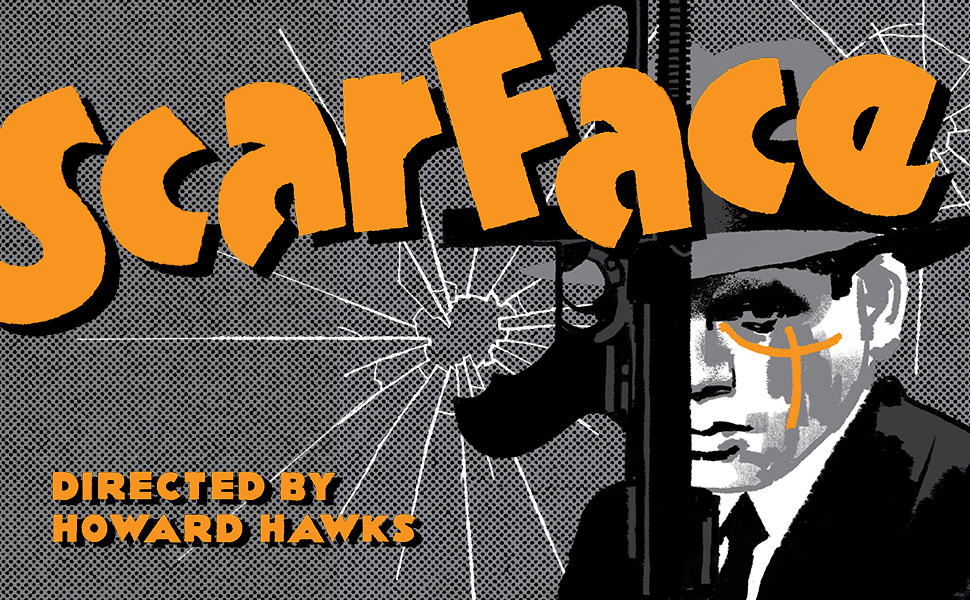Scarface (1932) has long been a touchstone of the gangster genre, and watching it today, its influence on later works is undeniable. Most notably, Brian De Palma’s 1983 remake shares Scarface’s title and its themes of ruthless ascent, but while De Palma’s film revels in excess, Hawks’ treatment of gangster culture feels more chilling in its cold realism. The new 4K transfer from Criterion and its Mono track are both excellent. The oddball bonus features are a blast to watch. Highly Recommended!
THE FILM
Though often overshadowed by its more famous 1983 remake, Scarface (1932), directed by Howard Hawks and produced by Howard Hughes, remains a towering achievement in American cinema, both audacious in its defiance of censorship and groundbreaking in its depiction of power, violence, and the American Dream. Released in the early days of the Hays Code, which sought to impose moral restrictions on Hollywood films, the original Scarface pushed boundaries that would have seemed unfathomable for mainstream cinema at the time. Its portrayal of a morally bankrupt, ruthlessly ambitious gangster was so incendiary that the film faced extensive cuts and censorship demands, which Hawks and Hughes; refusing to be cowed; largely ignored, resulting in a film that feels as raw and modern today as it did nearly a century ago.
Loosely based on Armitage Trail’s 1929 novel, itself inspired by the notorious gangster Al Capone, Scarface introduced audiences to Tony Camonte, played with electrifying intensity by Paul Muni. A figure of almost complete moral vacancy, Camonte is introduced as a henchman, already entrenched in the violent bootlegging world, but with grander ambitions. The opening sequence, in which a bullet-riddled body tumbles from a window and the camera lingers on a pair of hands tightly gripping a revolver, sets the tone for what is to follow, relentless, unforgiving violence and the inexorable rise of a man who will stop at nothing to claim power. The film is built on this chilling momentum, diving straight into Camonte’s unchecked ambition, which quickly transforms him from a lowly enforcer to a ruthless crime lord; cutthroat, domineering, and totally unmoored from any semblance of morality. The film’s brilliance lies not just in its gripping story, but in the way it captures Camonte’s increasingly dehumanized ascent. As he rises in stature, accumulating wealth, power, and possessions, the visual language of the film shifts subtly. Hawks uses costume changes, lighting, and framing to reflect Tony’s growing sense of dominance. His swagger, his total disregard for others, and his bizarre, almost incestuous attachment to his sister (played by Ann Dvorak) add complexity to the character, turning him into a tragic figure of obsession and self-destruction. Camonte’s only weakness is his family, particularly his sister, who remains an object of his twisted affection, a vulnerability that ultimately leads to his downfall. His journey is a violent one, but it is also marked by an undeniable narcissism that makes him both terrifying and strangely pitiable.
Despite his screen time, Hawks is never interested in making Camonte sympathetic. The character is an antihero in the truest sense; full of ambition and brimming with cruelty but Hawks keeps the audience at arm’s length. We watch with morbid curiosity, not empathy. This cold, distanced approach creates a sense of horror as we see Tony’s increasing power reflected in the mounting body count, the rapid-fire violence, and the ruthless pragmatism with which he destroys anyone who threatens his ascent. The film’s montage sequences, particularly the scenes in which the calendar pages fall away; marking time as bodies drop and lives are ruined; serve as a visual shorthand for the ceaseless, grinding nature of Camonte’s ambition. One of the film’s most remarkable achievements is its ability to juggle such dark material while still offering moments of levity, particularly through the character of Angelo (played by George Raft), Camonte’s third-in-command. Angelo, who eventually meets a tragic end, provides a brief respite from the bleakness, his comedic missteps offering a flicker of humanity in an otherwise brutal narrative. This juxtaposition of humor and horror is a hallmark of Hawks’ directorial style, providing depth to characters who otherwise might be reduced to one-note archetypes.
The film’s ultimate impact is tied not just to its sensationalism, but to its cultural legacy. Scarface was a blueprint for future gangster films, with its mix of violence, ambition, and American grit influencing everything from The Godfather to Goodfellas. And yet, what sets it apart is its daring disregard for moral ambiguity. Camonte is not a tragic hero, nor is he a victim of circumstance; he is a product of the violence he helps perpetuate, and the film unflinchingly makes that clear. The moral lesson, delivered in a forced “condemnation” scene added post-production to appease the censors, feels hollow, as if the film itself is too bold and too confident in its depiction of moral decay to be concerned with such moralizing. Hawks and Hughes did not pull punches. In the end, Scarface (1932) is a powerful work that remains as resonant today as it was nearly ninety years ago. Its portrayal of violence, ambition, and corruption; viewed through the lens of the American Dream, set the template for nearly every gangster film that followed. Its story of a man’s rise and fall is both timeless and terrifying, but it is the sheer force of its audacity, both in its themes and in its defiance of censorship that continues to make it a landmark in cinematic history. Even today, watching it feels like witnessing something both deeply wrong and, at the same time, undeniably compelling.
THE PACKAGING
Scarface (1932) wacks its way to 4K + Blu-ray via the Criterion Collection. Both discs are housed inside a hard, clear plastic case with spine #1239. The artwork features a new illustrated image of Muni as the Scarface himself with an automatic gun across half of his face. There is no Insert for a Digital Code, however, there is a booklet.
BUY THE CRITERION 4K HERE
THE VIDEO
According to Criterion: This new 4K restoration was created from a 35mm duplicate negative. This release of Scarface in 4K is an event for cinephiles, a majestic, long-overdue restoration of Howard Hawks and Howard Hughes’ audacious gangster classic. A film whose significance in American cinema can hardly be overstated, Scarface is, in this new transfer, an experience that feels as visceral and relevant today as it did nearly ninety years ago. Viewed in native 4K, the restoration offers a remarkable upgrade from prior home video releases, delivering a sharp and clean image that truly showcases the detail and intricacies of Hawks’ original compositions. From the striking opening shots; so heavy with shadow and menace; to the riotous, high-velocity action sequences that punctuate Tony Camonte’s violent rise, the image stands out for its clarity, depth, and, most impressively, its handling of dark sequences. For a film this old, the balance between shadow and light is surprisingly well-executed, with the nuances in the background and the grain structure of the film stock nicely preserved. There’s no noticeable crush in the darker areas, an issue that often plagues older films in digital restorations, which makes the 4K version all the more pleasing to behold.
Still, it would be remiss to ignore the minor but noticeable flaws in the restoration. There are occasional density fluctuations, small inconsistencies in the image that, while not intrusive, are definitely present. These are inherited limitations of the original print, rather than a result of the restoration process itself, and as such, can’t be fully eradicated. Transitions between scenes sometimes feel a little uneven, a quirk that echoes the imperfect nature of the source material. However, these issues are hardly deal-breakers in the grand scheme of things, and the overall stability and health of the image are strong. The 4K transfer may not be perfect, but it’s undeniably impressive. Hawks’ Scarface was already a pioneering work in its time, with its shocking violence, its unsparing view of gangster ambition, and its radical disregard for censorship. In this new restoration, the film’s raw energy; its darker shadows, and taut performances; feel more alive than ever. Even with its minor imperfections, this restoration is a testament to Criterion’s commitment to preserving film history with care and precision. For those fortunate enough to experience Scarface on a large, 4K screen, the result is nothing short of revelatory.
THE AUDIO
While the Criterion Collection’s 4K restoration of Scarface dazzles with its crisp, high-definition visuals, the accompanying LPCM 1.0 mono audio track is a reminder of the film’s era; a product of 1930s cinema with all the technical limitations that entails. Nevertheless, within these constraints, the sound design is more than serviceable, and in some ways, even adds to the historical authenticity of the experience. The track, naturally confined to a narrow soundstage, conveys a clear, unpretentious realism. Dialogue is handled well, with the voices of Paul Muni and his co-stars delivered in a clean, easily intelligible manner. There’s an intimacy to the vocal mix, evoking the feeling of sitting in a smoky theater, watching the action unfold on a smaller, more focused screen.
The actors’ voices carry an almost tactile quality; clear but without the sharp edges of modern technology like a dusty record player faintly crackling beneath a distant hum. The overall tone of the track fits the film’s period, adding a layer of vintage charm without becoming intrusive. The overall audio experience is devoid of distracting anomalies. There’s no intrusive hiss or crackle, a testament to the care with which this track has been preserved. But while the sonic quality is free of degradation, it remains very much a product of its time, with limited spatial depth and a narrow, sometimes flat dynamic range. In this sense, the mono track perfectly complements the film’s vintage aesthetics; a nostalgic relic that remains essential to understanding Scarface as a piece of cinematic history.
THE EXTRAS
There are no extras on the 4K Disc. All of the bonus features are located on the Blu-ray Disc. There are some interesting segments, including comedian Bill Hader discussing the movie.
- Megan Abbott and Bill Hader Discuss The Film
- Film Scholar Lea Jacobs Talks About the Film
- Alternate Ending
- Booklet
THE ULTIMATE WORD
The Criterion Collection’s release of Scarface (1932) is, without question, the finest version of this film available. The 4K restoration preserves the gritty, shadowy essence of Hawks’ vision while presenting it with newfound clarity and richness. The Mono audio track also sounds great within its limits, and the bonus features are a fun, wild ride. Whether you’re a longtime admirer of the film or a newcomer, this is a must-have for any cinephile. Highly recommended.







